The Birds Sure Liked The Berries At The Susquehanna Wetlands
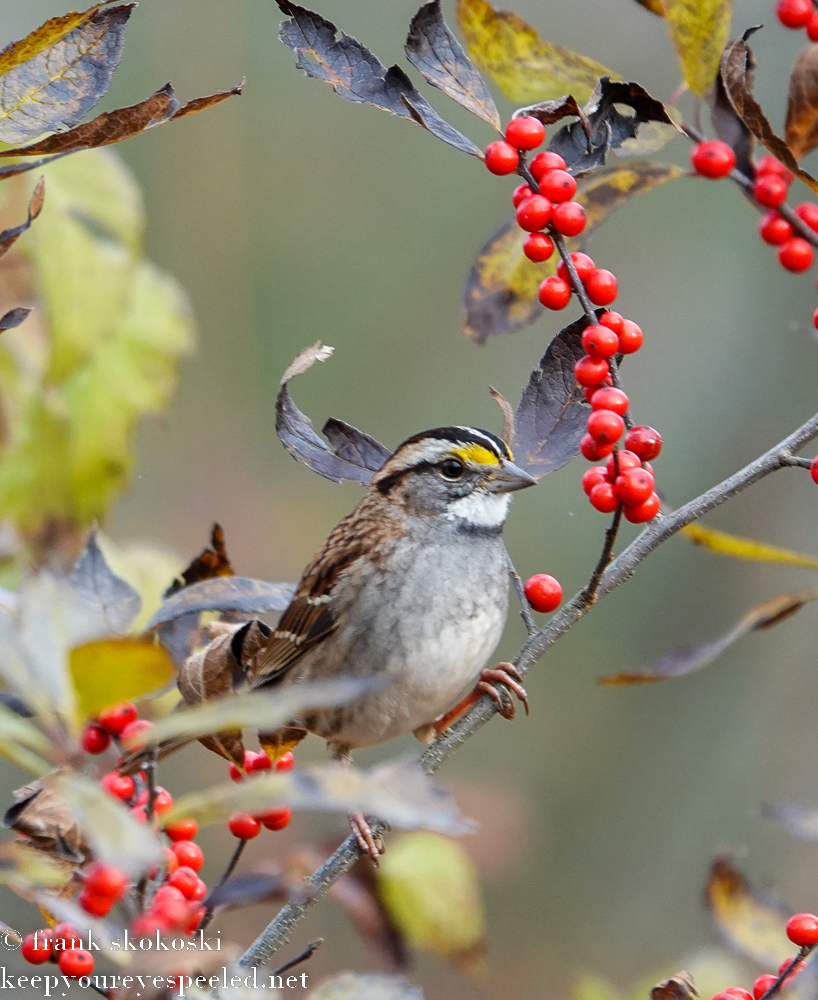
I wasn’t sure where to hike when I awoke Saturday morning. It was the latest sunrise of the year and still dark when I took my usual two mile morning walk through my neighborhood. I have been taking my morning walk, in all kinds of weather, for over 30 years. It was a beautiful sunrise and I decided, as I often do, to drive to the Susquehanna Wetlands in Salem Township Luzerne County. I wasn’t expecting to see a lot of wildlife or bird activity, as I do in the warmer months, but I am always hopeful I may see a bald eagle soaring over Lake Took-A-While on my five mile hike in the wetlands and river lands. 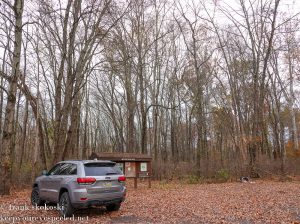
It was seasonably cool 40 degrees and mostly cloudy when I arrived at the wetlands. I was excited when I drove into the parking lot and saw a thrash can overturned. I hoped there might be a bear in the wetlands. I saw two here since I started hiking here about 12 years ago, rare cinnamon bear and a large male bear. As usual I first hiked down to the scenic and historic Susquehanna River, one of the oldest rivers on our planet.at
I walked back up to the wetlands , where I found the trees were now almost completely bare,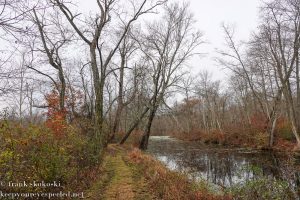
and the trails covered in leaves. It was quiet at first too, no sounds of birds, insects, frogs or other wildlife.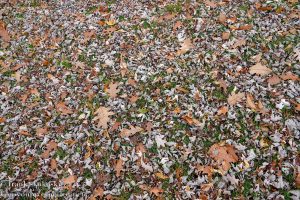
Only the oaks, the last to get their leaves in the Spring still had many leaves clinging to their branches. A few maple and sycamore trees had a couple of lingering leaves but most were now naked until the first new leaves of Spring appear. 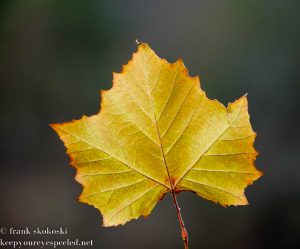
There were no wildflowers blooming in the wetlands, not a one. Some green remained on some small plants like the garlic mustard and nettle. The duck weed plants on the canals and ponds also were still thriving ion the colder and darker Fall weather and provided a green contrast to the brown leaf covered grounds. 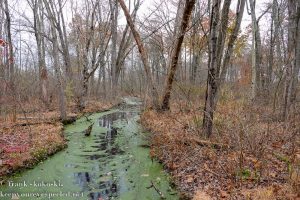
The bracken, eastern hay scented and these cinnamon ferns, so lush and green in the Spring were now brown and crumpled. 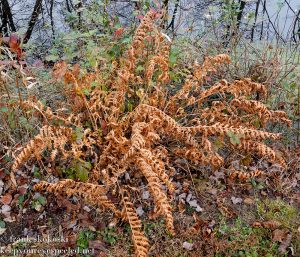
Some color was provided by the many red berries clinging to the branches of the native winterberry shrubs. These shrubs are an important source of food for birds in our cold Winters as I would see later on my hike, . 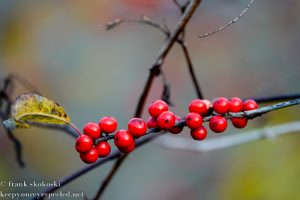
As I walked over the fallen leaves on the trail I heard a rapping overhead and saw this red-bellied woodpecker searching for grubs and insects on a tree trunk near the trail, 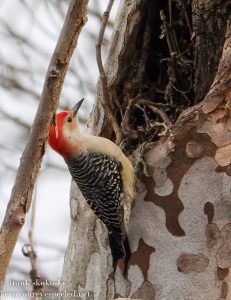
While watching the woodpecker I saw this female red-winged blackbird high in the branches of a tree. These birds usually migrate from the wetlands in the Winter to fields further south. They are not long distance migrants and some may stay during a mild Winter. 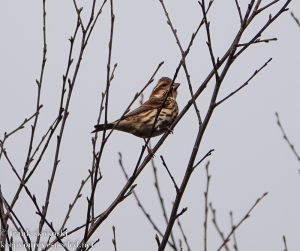
Nearby I heard the subtle calls and soft songs of a flock of golden crowned kinglets feeding on some poison ivy berries. These small birds are constanly moving and very difficult to photograph. They breed further north of our area and migrate here and further south in the Winter. 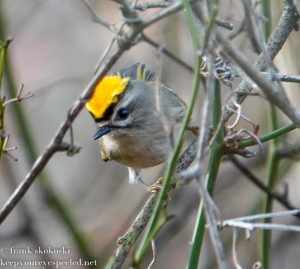
There was a few black-capped chickadees also feeding on the poison ivy berries. These berries are another important source of food for the birds and other wildlife during our long cold Winters. 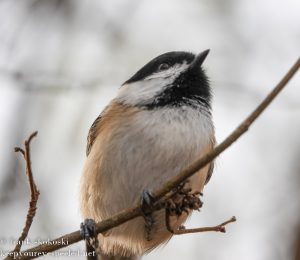
Nearby a few song sparrows scurried in the underbrush along the trail. These birds are with us all Summer and will stay for our Winter.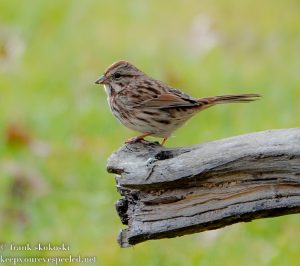
And I also saw a winter wren and 
a Carolina wren in the lower trees and shrubs near the ground , both are year round residents in the wetlands. 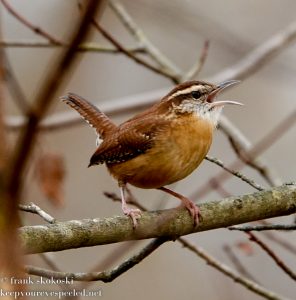
Swamp sparrows, year round residents, 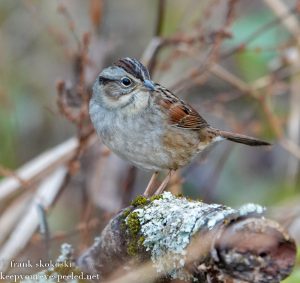
and white-throated sparrows were also active in this area of the trail. The later a pretty bird that migrates here for our Winter was feeding on the many winterberries found on the trails in the wetlands. 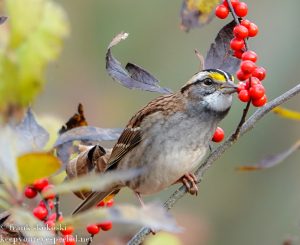
I watched as a small flock devoured many of the berries. I enjoy seeing these birds every Fall. They also breed to our north and migrate here for the Winter. 
I continued my walk through the wetlands and came to the Water Fowl Pond. I usually see wood ducks, mallard, great blue herons or other water fowl on this pond. There were no water birds on Saturday. 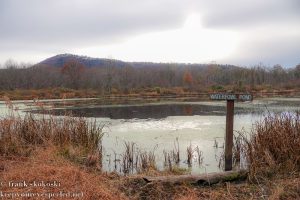
However, as usual, there were some eastern blue birds near the pond, feeding on the berries produced by the many poison ivy vines twining their way up the trunks of the trees. 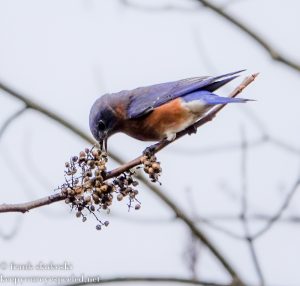
And their was also a large flock of yellow-rumped warblers feeding on the poison ivy berrries. These birds will be migrating south and I saw many of them on my recent trip to Panama and on my travels to Florida in the Winter. 
I left the Water Fowl Pond and walked the trail back toward the river lands. 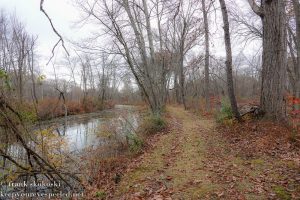
Along the way I saw this downy woodpecker, 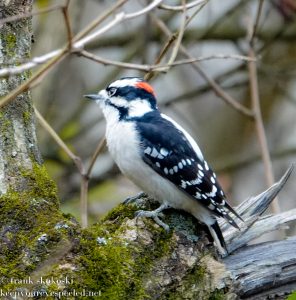
and a flock of cedar waxwings that were feeding on rose hip berries and winterberries. 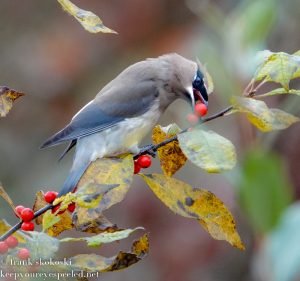
I love these dignified looking birds, 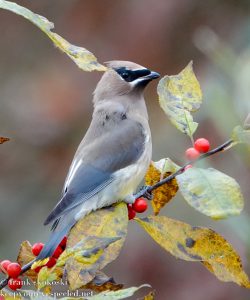
and watched the small flock almost clean the shrubs of all of the berries. Although these birds do breed in Northeastern Pennsylvania I rarely see them in the Wetlands in the Summer or Winter, I usually see them passing through in the Fall. Well they were well feed off of the winterberries in the wetlands. 
I walked along the canals and ponds in the wetlands and, just as I was leaving. I was surprised by a small flock of mallards and a couple of wood ducks that flew off of a pond. I never have seen them on this pond all Summer so I wasn’t expecting them and didn’t get any photos. 
I walked into the river lands,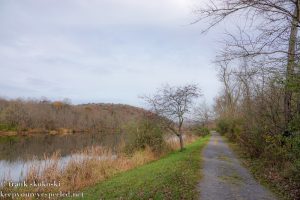
and found the a few New England asters still blooming after the frosts and freezes we had this past week. 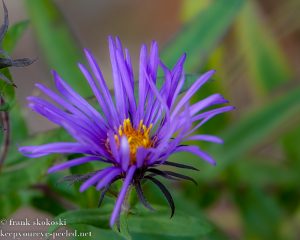
There were no Canada Geese or great blue herons on the waters of Lake-Took-A-While, 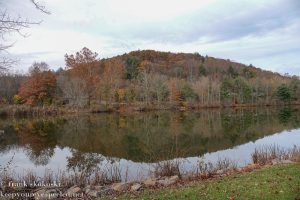
but I heard a belted kingfisher and saw a male mallard duck fly off near the far end of the lake but to quick to get a photo. 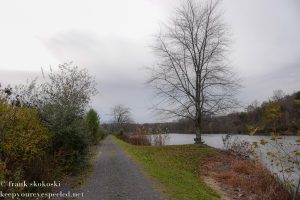
As usual I began my hike back to the wetlands at the far end of the lake. On the way I saw a few more birds on the trail along the lake, including a few American robins, 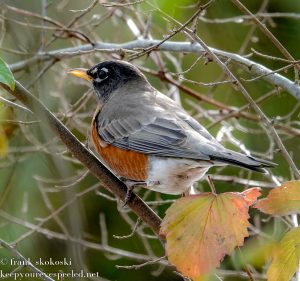
some male red winged blackbirds, 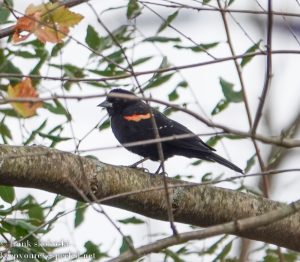
and a common sight here in the Winter, dark-eyed juncos or “snow birds” . They breed further north and visit the wetlands and our backyards during the Winter. Seeing them in my backyard feeders is a sure sign the colder weather is coming. Here is a link to a gallery on my blog website with some more photos of the birds I saw on my hike. Susquehanna Wetlands birds November 4 2023. 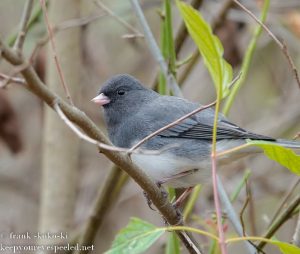
I didn’t see any more birds on my hike back, I usually don’t since I am tired and hungry and don’t a take the time to look for the more common birds. I will stop and try to photograph any less common species of bird but I didn’t see any Saturday. I did see this gray squirrel eating an acorn in a tree near the parking lot. Here is a link to another gallery with some more photos from my hike in the wetlands. Susquehanna Wetlands November 4 2023. 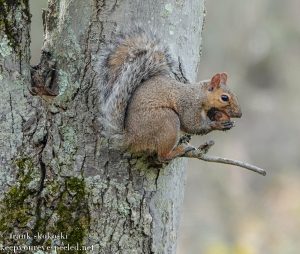
I wasn’t expecting to see much wildlife or bird activity on this early November morning, but once again the wetlands and river lands surprised. I was able to watch, and share some of the many species of birds that live in and travel through our area even in the Fall and Winter. It is a wonderful place to hike and observe nature, even in colder, dark and leafless months.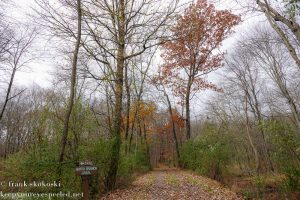
“God gives every bird its food, but He does not throw it into its nest.”- Josiah Gilbert Holland.
Tags
Categories
Recent Comments